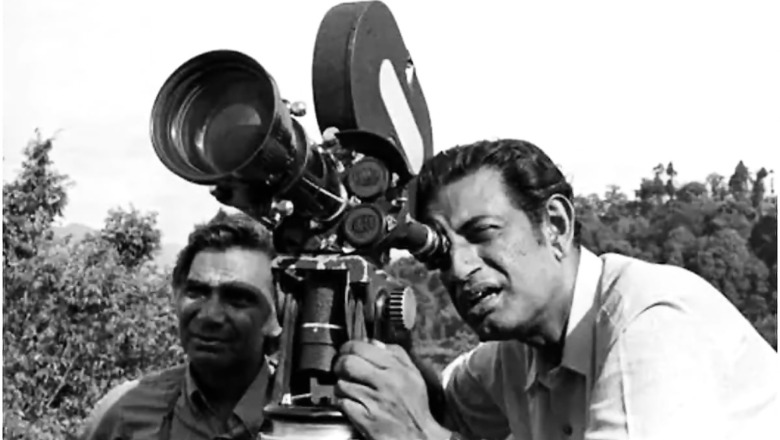
views
The first Bengali novel that Ray had wanted to make a film on was actually Rabindranath Tagore’s Ghare Baire, many years before he started working on Pather Panchali. He even wrote the screenplay for it. However, negotiations with producers did not materialize and the project was abandoned. Years later, on reading his old script, Ray found it too melodramatic. He did, however, finally make Ghare Baire four decades later in 1984.
***
Ray’s mother Suprabha Devi had not been in favour of Ray quitting his secure job with a regular income to become a full-time film-maker at first — an understandable stance given their financial instability before Ray took up his advertising job. Interestingly, after Dr B.C. Roy was agreeable to a grant for Ray to complete Pather Panchali, some government officials who saw the footage did not understand the content of the film and mistook it for a documentary on rural upliftment. So, they put the loan down in their records as one given for ‘road improvement’, a probable association with the translation of the film’s title, Song of the Road. Dr Roy extended his good offices even further — he arranged a special screening in Calcutta for then Prime Minister Jawaharlal Nehru, who was impressed enough by the film to recommend it as India’s entry for the 1956 Cannes Film Festival in spite of reservations from different fronts. The film won the award for the Best Human Document at Cannes, one of many awards it won nationally and internationally.
***
One of the pioneering figures of modern Indian art and Ray’s teacher at Kala Bhavan, Nandalal Bose, once told Ray: ‘Draw a tree but not in the Western fashion. Not from the top downwards. A tree grows up, not down. The strokes must be from the base upwards . . .’ This made Ray realize how art must also grow organically, just like life. Along with his three friends, he also undertook a tour of places of artistic interest in India. The tour drew his attention to the symbolism in Indian art, to the small details that signify bigger meanings—a quality that his films demonstrated greatly.
***
Not many know that after the success of his fantasy-adventure film Goopy Gyne Bagha Byne, Ray had wanted to remake the film in Hindi. The legendary poet, lyricist and film-maker Gulzar had started work on the script for the film. But when he was halfway through the script, Ray had to shelve the film, probably because of a rift with the producers. Fifty years after the release of Satyajit Ray’s GGBB in 1969, an animated adaptation of the classic, directed by Shilpa Ranade, was released. It is based on the Hindi translation of the original by Gulzar.
***
Satyajit Ray and Pandit Ravi Shankar were great friends. Shankar gave music to four of Ray’s films — Pather Panchali, Aparajito, Apur Sansar and Parash Pathar. When Ray had approached Pandit Ravi Shankar to compose music for his first film, Pather Panchali, the latter gladly agreed. Pandit Ravi Shankar was so moved by the rushes of the film that he composed the music in four-and-a-half hours straight. Around this time, Ray had also conceptualized a documentary film on the legendary sitarist, which was to be shot during one of his recitals. Ray had even worked out a detailed storyboard for the film containing over a hundred detailed sketches and notes on the camera movements. He had tentatively titled it A Sitar Recital by Ravi Shankar. But for reasons unknown, the film didn’t take shape and his plan to make a film on his musician friend remained a wish unfulfilled.
***
Ray was quite a foodie. He loved dining out. He used to visit the famous Flurys in Calcutta every Sunday morning for breakfast. He preferred mutton over chicken and, while he relished continental cuisine, he thoroughly enjoyed the Bengali fare. He especially loved luchi, arhar dal and begun bhaja. He also loved to eat muri, or puffed rice, mixed with ghee and sugar. Ray was very particular about his eating habits and his regular food in the studio was usually chicken sandwich and curd. In his cult classic, the fantasy-adventure-comedy-musical Goopy Gyne Bagha Byne, the legendary filmmaker went all out with his love affair with food as the king of ghosts bestows Goopy and Bagha with three boons — the first of them being that they could get unlimited delicious food just by clapping their hands!
***
When Ray was informed that he would be receiving an Honorary Award from the Academy of Motion Picture Arts and Sciences, it is said that he requested that his favourite Hollywood actress, Audrey Hepburn, present it to him. And so she did. For the 64th Academy Awards on 30 March 1992, from the Dorothy Chandler Pavilion in the Los Angeles Music Center, USA, Hepburn presented his award virtually. Ray accepted the award on tape from his hospital bed in Calcutta, which was beamed via video link to the audience at the Oscar ceremony, along with his acceptance speech. Ironically, both Ray and Hepburn were dying. He passed away a few weeks later on 23 April 1992 and she passed away a few months later, on 20 January 1993, of cancer.
Excerpted from Satyajit Ray in 100 Anecdotes by Arthy Muthanna Singh and Mamta Nainy, with permission of Penguin Random House.
Read all the Latest News, Breaking News and Coronavirus News here. Follow us on Facebook, Twitter and Telegram.



















Comments
0 comment